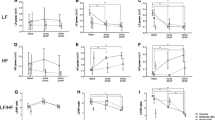Summary
The pulmonary artery pressure values of 65 patients with sleep apnea syndrome were measured at rest and during ergometer exercise up to 100 W. Pulmonary hypertension at rest was found in 13, and during exercise in 31 more patients. Only 8 patients with pathological pressure findings suffered from pulmonary hypertension in combination with a pulmonary or cardiac disease. In the other 36 patients, no indication of a primary cause of pulmonary hypertension apart from sleep apnea syndrome could be found. Out of the 65 patients, 11 with a finding of more than 20 apnea episodes per hour's sleep underwent polysomnographic recordings in the sleep laboratory. The hemodynamic parameters were continuously measured. All 11 patients had a finding of severe sleep apnea with more than 300 apnea episodes during the night of recording. In 6 patients, the appearance of apnea episodes was accompanied by only moderate changes in pulmonary artery pressure. In 5 patients, there were critical increases in pulmonary artery pressure, which went along with increases in cardiac output and in pulmonary capillary wedge pressure. Increases in pulmonary vascular resistance were established in 3 out of these 5 patients, and a slight decrease in 2. The mechanism of hypoxic vasoconstriction of the pulmonary arteries may account for the pressure increases in 3 of our patients, but fails to explain the findings in the other 2 patients. Nocturnal changes in pulmonary artery pressure in patients with sleep apnea may therefore have different causes. Pulmonary hypertension constitutes a severe complication in patients with sleep apnea. As 55% of all sleep apnea patients were found to suffer from pulmonary hypertension without any indication of a primary pulmonary or cardiac disease, the possibility that pulmonary hypertension results should not be underestimated in patients with suspected sleep apnea syndrome. Measurements of the pulmonary artery pressure must therefore be included in the examination regimen of such patients.
Similar content being viewed by others
Abbreviations
- ECG:
-
electrocardiogram
- REM:
-
rapid eye movement
References
Blount SG, Grover RF (1978) Pulmonary hypertension. In: Hurst JW (ed) The heart, arteries and veins. Mc Graw-Hill, New York, pp 1456–1472
Boysen PG, Block AJ, Wynne JW, Hunt LA, Flick MR (1976) Nocturnal pulmonary hypertension in patients with chronic obstructive pulmonary disease. Chest 76:536–542
Buda AJ, Schroeder JS, Guilleminault C (1981) Abnormalities of pulmonary artery wedge pressures in sleep-induced apnea. Intl J Cardiol 1:67–74
Coccagna G, Mantovani M, Brignani F, Parchi C, Lugaresi E (1972) Continuous recording of the pulmonary and systemic arterial pressure during sleep in syndromes of hypersomnia with periodic breathing. Bull Physio-Pathol Respirat 8:1159–1172
von Euler US, Lijestrand G (1946) Observations on the pulmonary arterial blood pressure in the cat. Acta Physiol Scand 12:301–320
Guilleminault C, Eldridge FL, Simmon FB, Dement WC (1975) Sleep apnea syndrome. Can it induce hemodynamic changes? West Med 123:7–16
Guilleminault C, Tilkian A, Dement WC (1976) The sleep apnea syndromes. Am Rev Med 27:465–484
Nattie EE, Bartlett D, Johnson K (1978) Pulmonary hypertension and right ventricular hypertrophy caused by intermittent hypoxia and hypercapnia in the rat. Ame Rev Respir Dis 118:653–658
Peter JH, Becker E, Fuchs E, Meinzer K, von Wichert P (1982) Ambulante transkutane Langzeitregistrierung von arterieller Sauerstoffspannung und Herzrhytmusstörungen bei Patienten mit Schlafapnoesyndrom. Verh Dtsch Ges Inn Med 88:390–393
Podszus T, Becker I, Bongartz F, Mayer J, Peter JH, von Wichert P (1984) Schlafapnoe und pulmonale Hypertonie. Verh Dtsch Ges Inn Med 90:1105–1107
Scharf SM (1984) Influence of sleep state and breathing on cardio-vascular function. In: Saunders NA, Sullivan CE (eds) Sleep and breathing. Marcel Dekker, New York Basel, pp 221–240
Schlant RC (1978) Normal physiology of the cardiovascular system. In: Hurst JW (ed) The heart, arteries and veins. Mc Graw-Hill, New York, pp 71–100
Schroeder JS, Motta J. Guilleminault C (1978) Hemodynamic studies in sleep apnea. In: Guilleminault C (ed) Sleep apnea syndromes. Alan R Liss, New York, pp 177–196
Author information
Authors and Affiliations
Rights and permissions
About this article
Cite this article
Podszus, T., Bauer, W., Mayer, J. et al. Sleep apnea and pulmonary hypertension. Klin Wochenschr 64, 131–134 (1986). https://doi.org/10.1007/BF01732637
Received:
Revised:
Accepted:
Issue Date:
DOI: https://doi.org/10.1007/BF01732637




